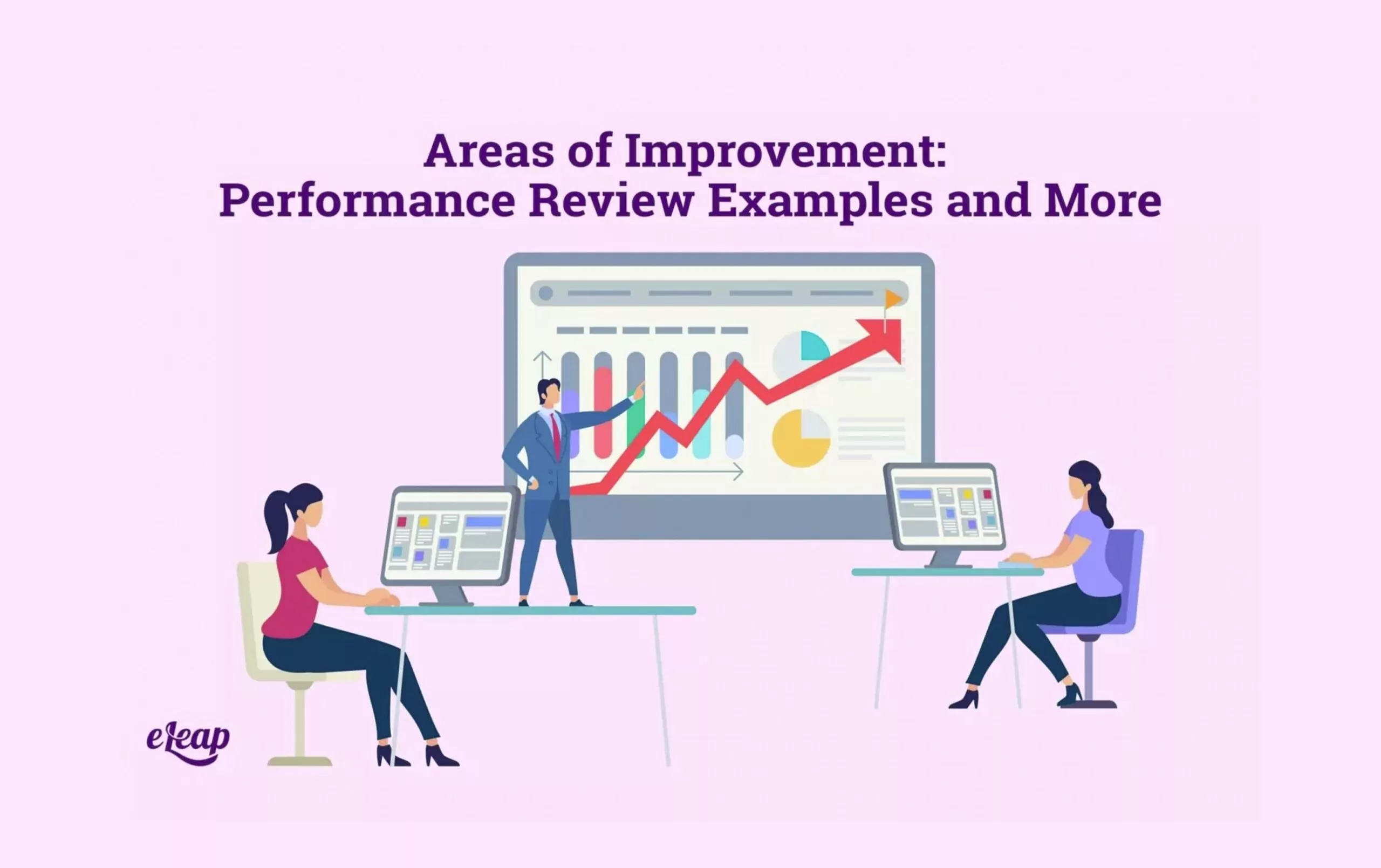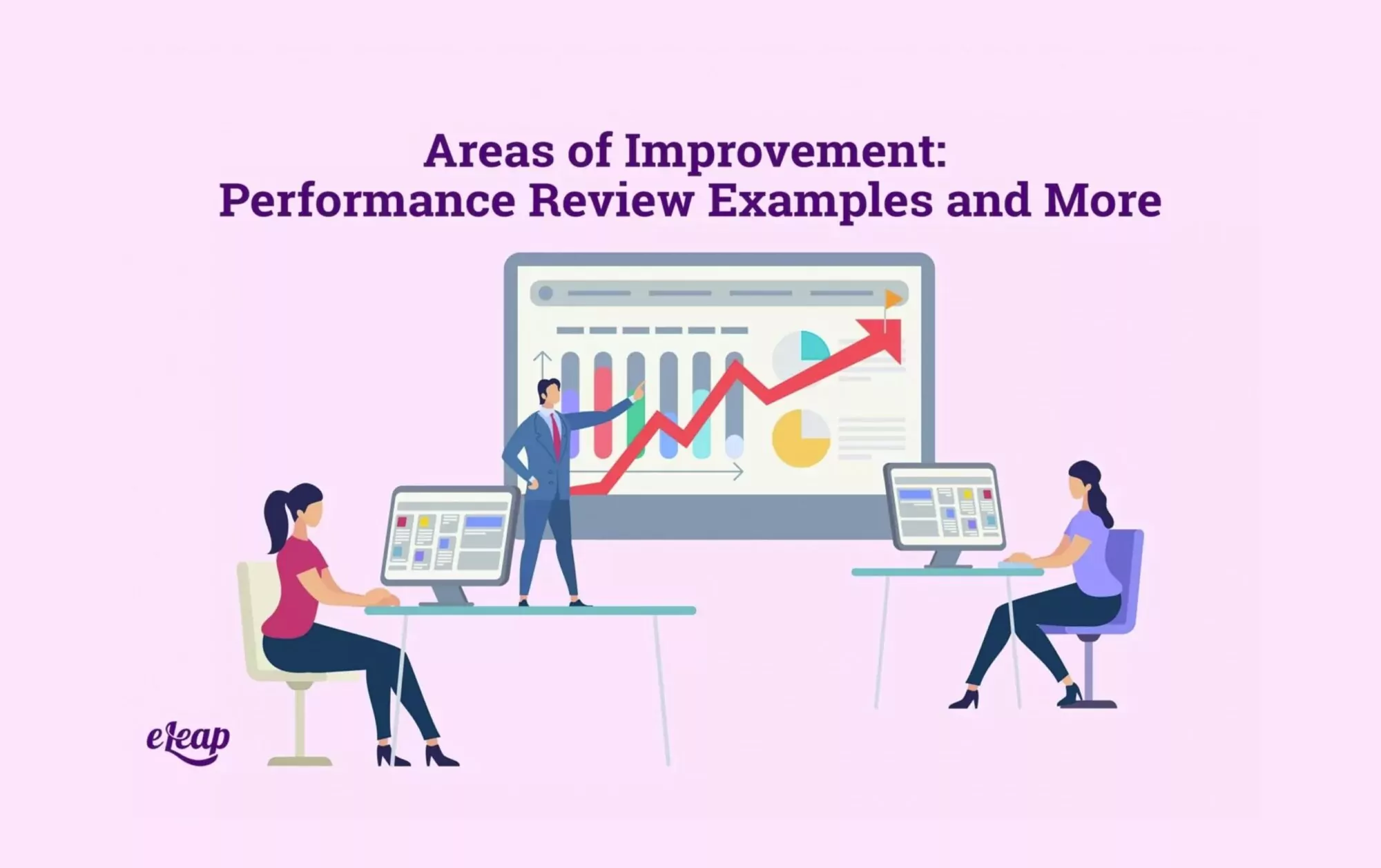Areas of Improvement: Performance Review Examples and More

Performance reviews can’t just be critique sessions where managers simply list off all the things employees need to work on—that would burst morale in a second, and at a time when company culture and employee engagement matter more than ever before, you’ve got to make a positive move when it comes to performance reviews. Understanding how to properly address areas of improvement in performance review sessions will be the first step in creating a team that’s dedicated to growth and development within their roles. Explore how eLeaP’s Performance Management Platform can simplify evaluations, boost productivity, and drive measurable results.

It’s always been a challenge for leaders and managers to find the right words to convey employee performance feedback. When evaluating employee performance, there’s a need to find a balance between being honest and motivating employees while also critiquing areas of improvement and gauging how they feel about their performance.
Today, the stress and uncertainty caused by the world we live in can create an even more stressful air around the performance review. When you combine that with the Great Resignation and all the people who weren’t willing to stick around for companies that didn’t know how to handle performance reviews and employee performance in general, you can see that something needs to change.
Fortunately, there are several areas of a performance review that you can discuss with an employee, and not all of them are negative. For example, while you might discuss areas of improvement, performance review examples also include a discussion on setting new goals, acknowledging accomplishments and growth, and so forth. To get the most out of your performance review, start a free 30-day trial of eLeaP and learn how the platform helps to maintain efficiency, engagement and growth, and results.
How to Present Constructive/Negative Feedback
When you approach employees for a performance review, it can immediately send stress signals, cause their minds to race and worry about what they might have done “wrong,” and create a sort-of defensiveness if you aren’t clear and communicative about the review process. For years, employees have feared the annual performance review, worried that they didn’t measure up to the generic metrics and check all the boxes, and therefore they will be chastised for their performance and/or kept from the rewards of a good review (such as a bonus or a pay raise).
The first thing every organization needs to do is to stop tying the feedback and review process to salary. Yes, these reviews are a great way to determine if employees have grown and are worthy of a pay increase, but it’s about much more than that. Performance management and giving employee reviews is about helping people to grow and develop so that they can fulfill the duties of their role and perhaps even go above and beyond them as they grow and develop within the company.
Presenting negative feedback has always been a matter of debate. Many organizational leaders still enjoy the sandwich method of feedback, which is a simple way to ensure that more good things than bad are shared. The feedback sandwich looks like this:
Positive feedback/recognition
Negative feedback/constructive criticism
Positive feedback/recognition
This is an effective option, but it can also come off as too much for employees—too structured, too standardized, and almost kind of forced. It is important to give positive feedback and constructive criticism, but perhaps more important than that is having a discussion with employees to understand where they need to improve. It’s also helpful if you can frame their missteps or mistakes as opportunities for improvement.
The review process can be a huge undertaking, but it doesn’t have to be overwhelming. Below, we’ll look at the six categories of performance reviews and how the areas of improvement can be presented in a way that employees will understand and appreciate instead of feeling attacked or singled out.
Six Areas of Improvement for Employee Performance
There are six main categories that you’ll want to look at when you are discussing performance with employees.
- Communication
- Achievements
- Collaboration/Teamwork
- Creativity
- Critical Thinking
- Flexibility
Communication
Employees need to have strong communication skills if they are going to be successful in any organization. Being able to communicate effectively with everyone across the organization is a very helpful skill to have. It will not only position employees to grow and develop further in their careers, but it will also help ensure that organizational communication is strong and effective.
Communication includes everything from interacting with co-workers and managers to email, client or customer interactions, presentations, and more. It’s not just about whether an employee has good communication skills but how their communication abilities support their role and help them strengthen relationships and their standing within the organization.
Achievements
This is usually one that’s easier to talk about because it’s all good conversation. It’s important to note employees’ achievements throughout the year. It’s even better to integrate a feedback process that allows you to connect weekly or monthly when accomplishments and successes are still fresh in everyone’s minds. Make sure that you highlight these during the review process to show employees how far they have come and that you notice how much of an asset they are to the organization.
Collaboration
You cannot have a successful organization without successful teamwork. Just being part of a team isn’t enough—you need people who are striving to create an environment of collaboration and teamwork that will help carry the organization into the future. It’s important to recognize how people have contributed in a team setting and how they work with others. This is also a good place to offer constructive feedback about how they could improve their teamwork and collaboration skills.
Creativity
Today, companies need innovative, creative thinkers at all levels of the organization. Being able to think outside of the proverbial box is a huge skill, and many companies are striving to find people who can do just that. After all, the biggest and most successful companies are those led by innovators, creators, and people who wouldn’t accept boundaries.
People can be creative on the job in several ways, but it starts with having an open mind and not being limited to a finite way of thinking. That’s sometimes difficult to do with lower-level employees, so it’s best to start at the beginning and include creative thinking as part of your list of requirements in all job postings.
Critical Thinking
Problem-solving and critical thinking skills are essential to an organization. After what everyone went through with the pandemic, companies have realized the value of critical thinking skills and the ability to solve problems at the drop of a hat. That also ties in a little with the next category (flexibility), but it is its own asset. People with good problem-solving skills will see obstacles as opportunities, be eager to identify new solutions, and will openly discuss the need for more efficient solutions.
Flexibility
Another skill companies have had to focus on since the pandemic is flexibility. Both organizations and their people need to be agile and adaptable. And ready to integrate change at a moment’s notice. The digital tools and resources are there. Today, all kinds of software and programs are scalable, agile, and easily changed. Your employees need to be the same way. The old-school employee that’s stuck in their ways and scared of change is not going to be any kind of asset to the organization. Get people to embrace being flexible or get new people. It’s that simple.
Areas of Improvement Performance Review Examples and Tips
Now that you better understand the categories covered in performance reviews, you can start thinking about how to present your employees with growth feedback or areas of improvement. When you are looking for ways to help employees improve their skills and abilities, you will want to avoid generalizations or big, undefined goals and suggestions. For example, rather than saying that an employee needs to “improve time management,” you would say:
Jim sometimes struggles to make timely decisions and wrap up projects when problems arise. He is not always sure of how to respond. In the future, Jim will work to reach out to management when he is uncertain of the response/action needed and work on being more decisive by furthering his industry expertise.
That’s a lot more effective, descriptive, and helpful than the generic answer. It explains exactly where “Jim” is missing the mark. What he can/will do to change that, and it is done in a way that is not condescending or just pointing out his flaws. Here are examples:
- Easily identifies efficient solutions and finds more streamlined ways to complete tasks.
- Is strong with collaboration software and capable of building relationships with all team members, regardless of department or rank.
- Shows a positive attitude and composure when changes need to happen quickly.
- Struggles to dissect and identify the root cause of problems, thereby making problem-solving more difficult.
- Gets overwhelmed and loses focus when unexpected tasks or challenges arise.
As you can see, the main point is to be clear, specific, and matter-of-fact. This kind of insight will help employees with all areas of improvement, no matter their role or their rank within the company. eLeaP has powerful tools and resources to ensure you have success when it comes to reviews and self-evaluations. Start your free trial today.